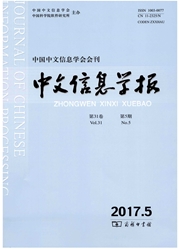

 中文摘要:
中文摘要:
该文用定量和定性分析相结合的方法,考察了现代汉语双音节形名复合词的物性修饰关系,发现形语素有选择地约束名语素的不同物性角色。当形语素修饰名语素的形式角色或构成角色时,语义解读时常需要补充名词;当形语素修饰名语素的施成角色、功用角色或规约化属性时,语义解读时常需要补充动词。形名复合词的语义建构是物性结构和概念整合共同作用的结果,当形语素激活的物性角色或物性值不止一个时,就会出现多义或歧义。
 英文摘要:
英文摘要:
This paper analyzes the qualia modification relationships of disyllabic adjective-noun compounds in Manda- rin both quantitatively and qualitatively. It reveals that an adjective morpheme selectively constraints the qualia roles of the noun morpheme. Generally, when the adjective morpheme modifies the formal role or the constitutive role of the noun morpheme, a noun needs to be added in the process of meaning construction. When the adjective morpheme modifies the agentive role, the telic role or the conventionalized attribute, a verb needs to be added. Furthermore, both qualia structure and conceptual blending contribute to the meaning construction of adjective-noun compounds. If an adjective morpheme activates more than one qualia roles or qualia values, there will be polysemy or ambiguity.
 同期刊论文项目
同期刊论文项目
 同项目期刊论文
同项目期刊论文
 期刊信息
期刊信息
